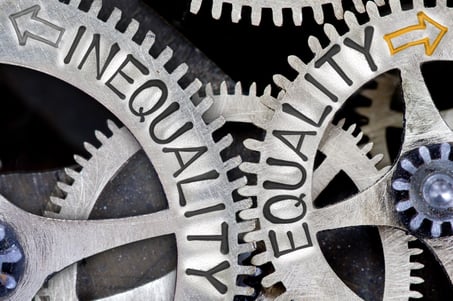
-
Eighty-seven percent of premature deaths due to noncommunicable diseases occur in low- and middle-income countries.
-
When controlling for differences in healthcare needs, a person with low income is five percentage points less likely than a person with high income to see a general practitioner.
-
If policy makers want to promote inclusive growth, they must ensure that health policies benefit the least well-off.
Social Inequality: A Threat to Well-Being
People from disadvantaged socioeconomic backgrounds frequently are in worse health, have higher exposure to risk factors and struggle more to access the health system than the better-off or better-educated. Interventions and services aimed at helping to change behaviors must be adapted to the reality of people’s lives, address the wider circumstances in which behaviors take place, and recognize the difficulty of achieving and maintaining behavioral change under conditions of stress.
The World Health Organization reports:
-
Every day 16,000 children die before their fifth birthday of pneumonia, malaria, diarrhea and other diseases. Children in sub-Saharan Africa are 14 times more likely to die before the age of five than those in the rest of the world. And children from the poorest 20% of households are nearly twice as likely to die before their fifth birthday as children in the richest 20%.
-
Developing countries account for 99 percent of annual maternal deaths in the world. Women in Chad have a lifetime risk of maternal death of one in 16, while a woman in Sweden has a risk of less than 1 in 10,000.
-
Around 95% of TB deaths are in the developing world.
-
Eighty-seven percent of premature deaths due to noncommunicable diseases occur in low- and middle-income countries.
-
A child born in Sierra Leone can expect to live for 50 years while a child born in Japan can expect to live 84 years.
Alarming health inequities exist within countries – and sometimes even within cities:
-
In the United States, African-Americans represent only about 13% of the population but account for almost half of all new HIV infections, with no biological or genetic reason.
-
The north of England has a higher concentration of deprived neighborhoods than the south, and therefore a greater proportion of communities where life expectancy is likely to be lower. Males living in the least deprived areas can, at birth, expect to live 9.4 years longer than males in the most deprived areas. For females, the gap is 7.4 years.
-
Within the city of Glasgow, male life expectancy ranges from 66.2 years in Ruchill and Possilpark, to 81.7 years in Cathcart and Simshill. And in London, when traveling east from Westminster, each tube stop represents nearly one year of life expectancy lost.
Wider Determinants of Health
The social, economic and environmental conditions in which people live have an impact on health. They include income, education, access to green space and healthy food, the work people do and the homes they live in. Some statistics:
-
Across countries for which data are available, people without a high-school diploma can expect to live about six years less than those with tertiary education.
-
When controlling for differences in healthcare needs, a person with low income is five percentage points less likely than a person with high income to see a general practitioner.
-
For cervical, breast and colorectal cancers, the probabilities that low-income people will have undergone screening in the recommended period are 17, 13 and 6 percentage points lower than that of high-income people.
-
3.7 million children in the UK live in households for whom a healthy diet is increasingly unaffordable.
Quality of Life Matters Too
The number of years a person is expected to live – that is, life expectancy – is one determinant of the value of a healthcare system, but it is not the only one. The number of healthy and/or disability-free years is important too. And here again, inequities exist. In fact, inequalities in both healthy life expectancy and disability-free life expectancy are even wider than inequalities in life expectancy. People in more deprived areas spend, on average, a far greater part of their already far shorter lives in poor health.
The Vicious Circle
Just as social inequity leads to poorer health, the converse is also true: Poor health perpetuates social inequity. The American Psychological Association found that U.S. households with annual incomes below $50,000 report higher levels of stress than other families. The association’s annual Stress in America™ survey draws attention to the serious physical and emotional implications of stress and the inextricable link between the mind and body.
Everybody’s Problem
People in disadvantaged groups aren’t the only ones negatively affected by social inequality. Health inequity has a significant financial cost to societies in terms of loss of productivity, reduced tax payments, higher welfare payments and higher healthcare costs. High levels of inequality also reduce social cohesion, which in turn leads to more stress, fear and insecurity on everyone’s part.
Solutions
A range of policy options exists to reduce social inequalities in health, including:
-
Public health interventions helping disadvantaged groups adopt more healthy lifestyles.
-
Measures to improve health literacy.
-
Reconfiguration of service delivery models to ensure that recommended preventive services are available to all.
-
New strategies to recruit and retain doctors in underserved areas, or the implementation of new service delivery models to decrease inequalities in access to care.
-
Addressing labor issues, education, housing and social policies.
-
Enabling access to services based on need rather than ability to pay
If policy makers want to promote inclusive growth, they must ensure that health policies benefit the least well-off.



Share Article